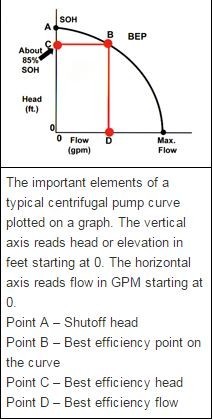One of the keys to consistent pump performance is discovering when your pump is operating at peak efficiency.
The best way to determine this is by identifying your pump’s BEP, or Best Efficiency Point. The BEP is a measure that shows where the pump is performing most effectively and is least likely to fail. A pump should operate at or near the best efficiency point. This should be provided by your pump manufacturer (our efficiency curves are listed on our website).
Operating near the BEP on the efficiency curve also provides financial benefits. Efficient pumps require less electricity, and thus less cost to operate. Another cost associated with BEP is initial design. Your pump system’s needs may be farther to the left or right of the BEP, so it is wise to choose a pump that best fits your specifications.
 One of the factors in determining BEP is the design of the impeller, which controls how power is transmitted to the liquid being pumped. Trimming the impeller also changes the efficiency curve. Another contributing factor is the speed of the impeller; as the speed changes, the efficiency and the BEP changes.
One of the factors in determining BEP is the design of the impeller, which controls how power is transmitted to the liquid being pumped. Trimming the impeller also changes the efficiency curve. Another contributing factor is the speed of the impeller; as the speed changes, the efficiency and the BEP changes.
However, due to the large number of applications and lesser number of pump models, it is not always possible to operate at the BEP. If you are running the pump at more than 40% left or right of the BEP, you should contact the pump manufacturer. The more left you are, you have to be concerned with minimum flow issues to prevent heat buildup in the pump.
When checking with the manufacturer, let them know your flow and the liquid’s temperature and concentration. For the right side, watch out for NPSH, or Net Positive Suction Head, to prevent cavitation. Make sure you have enough liquid entering the pump based on your desired flow rate. For example, if you are operating the TE-10K-MD model and you are on the far right of the curve at 200GPM, you must have 200GPM coming into the pump thru gravity.
The larger the pump, the more you want to be as close as possible to the BEP. March mag drive pumps, particularly the 7 series and smaller, are able to operate on a wider BEP bandwidth. However, the closer you are to the BEP, the longer the life of the pump.
Finding and operating near your pump’s BEP is important in producing the most efficient operation and providing the longest life. View the efficiency curves of the March chemical transfer pumps, and learn about our top impeller designs by contacting our engineers today.